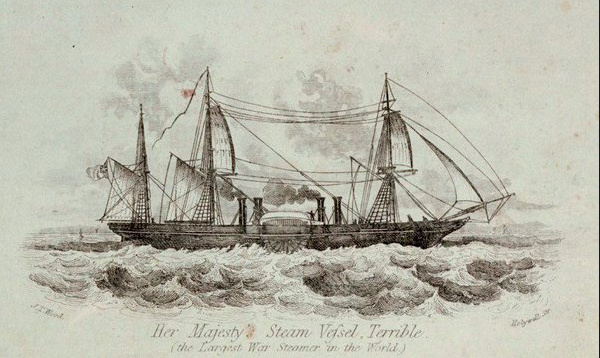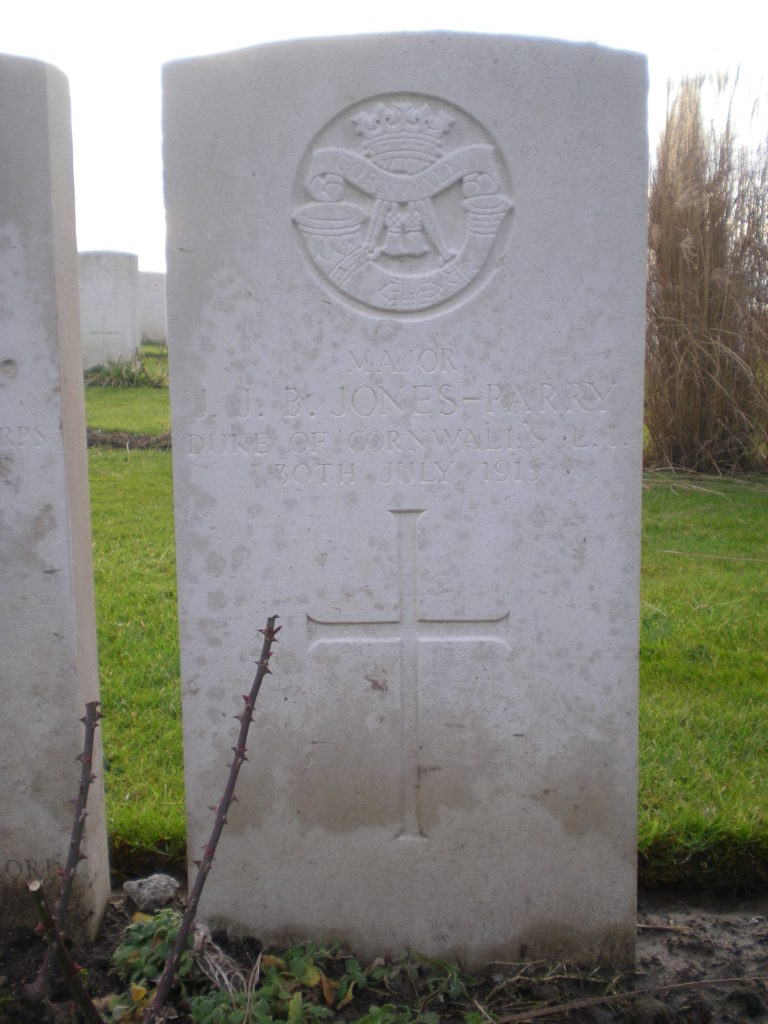Fact file:
Matriculated: 1882
Born: 12 December 1863
Died: 30 July 1915
Regiment: Duke of Cornwall’s Light Infantry
Grave/Memorial: Divisional Cemetery: D.8
Family background
b. 12 December 1863 as the eldest son (four children) of Rear-Admiral John Parry Jones-Parry, JP (1829–1920) and his first wife Catherine de Winton Jones-Parry (1832–95) (née Wilkins, from 1839 de Winton by Royal Licence) (m. 1861), of Torpoint, Cornwall, and later of Thelwell Hall, Warrington, Cheshire. At the time of the 1901 Census, Rear-Admiral Jones-Parry and his second wife, Marion Constance Jones-Parry (née Roome [1867–1955]) (m. 1898), were boarding in Kensington, London SW.
Jones-Parry’s father was a member of a naval family “of very ancient Welsh extraction” whose family seats were at Madryn Castle, inland from Pwllheli, Gwynedd, and the Dower House in Llanbedrog, Caernarvonshire. He joined the Navy in 1845 and quickly became an expert on gunnery and naval ordnance, which resulted later in his invention of a recoilless gun carriage with a mantle to protect the crew. He served on the steam-driven, wooden-hulled paddle warship HMS Terrible (1845–79; broken up) throughout the Crimean War and was present when she participated in the bombardments of Odessa and Sebastopol (1854). In 1863 he was promoted Commander and appointed to the Cambridge, the gunnery school-ship at Devonport.
Four years later he took command of the gun vessel HMS Steady (1860–70; scrapped) from 20 April to 5 July 1867 when she was off the west coast of Africa, and he then commanded the mine-sweeping torpedo-gunboat HMS Speedwell (1861–76; scrapped). He became a Captain RN on 29 December 1871 and retired in this rank on 1 October 1873. His promotion to Rear-Admiral followed on 1 January 1888, while he was on the Retired List. By the time of his death he had been on the Retired List for 46 years and was one of the oldest officers of his rank in the Royal Navy.
Jones-Parry’s mother came from a family of landed gentry whose remote ancestors had come to England with William the Conqueror.
Jones-Parry was a distant cousin of Sir Love Jones-Parry (1832–91), 1st Baronet of Madryn Castle, Liberal MP for Carnarvonshire (1868–74) and of Carnarvon (1882–86). In 1865 he was responsible for obtaining permission for 162 Welsh emigrants to settle permanently in Patagonia, Argentina.
Siblings and their families
Brother of:
(1) Blanche Catherine Rheingar (1862–1954) (Carden after her marriage [1881] to Major Henry Charles Carden, DSO [1855–1915], son of Sir John Craven Carden, 4th Baronet, killed in action at the Battle of Loos on 25 September 1915 while serving with the 8th Battalion, the Devonshire Regiment, no known grave]), two children;
(2) William Percival (1865–1959) (m. [1909] Ethel Maude Unwin); two children;
(3) Thomas Herbert Love (1867–1951) (m. [1896] Mary Williamson [1874–1931]), at least one son.
William Percival Jones-Parry was a “motor driver” by trade; he attested for the Royal Flying Corps on 16 July 1915 and became a 1st class Air Mechanic in 32 Squadron; he was discharged on 17 September 1917 as “No longer physically fit for war service” because of the exacerbation of a previous injury, and awarded a small pension.
According to the 1901 Census, Thomas Herbert Love had been an officer in the Mercantile Marine.
Wife and children
Jones-Parry’s wife was Helen Mary Beckford (née Johnstone) (1867–1959) (m. 1890). At the time of the 1911 Census, they and their third child were living at Warrenhurst, Firgrove Hill, Farnham, Surrey.
He was the father of:
(1) Jeffreys Ivor Jones-Parry (1890–1915; killed in action on 28 April 1915 by a Turkish shell during the Allied landings on the Dardanelles while serving as a Sub-Lieutenant (Royal Naval Reserve) on board the destroyer HMS Wolverine [1910–17; it sank with the loss of two lives after colliding with the fleet sweeping sloop HMS Rosemary off the north-west coast of Ireland] when she was supporting troops who were landing at Anzac Cove, no known grave);
(2) Helen Gwynedd (1895–1982) (later Szegedi-Szuts after her marriage [1937] to István Szegedi-Szuts [1893–1959]);
(3) Eve Sidney de Winton (1899–1980) (later Carr after her marriage [1925] to Reginald Frederick d’Argaville Carr [1900–91]), one son, one daughter.
István Szegedi-Szuts was a visual artist who emigrated from Hungary to England in 1929 and settled on the Lizard Peninsula, Cornwall, where he exhibited with the Newlyn Society of Artists.
Reginald Frederick d’Argaville Carr was Headmaster of St Erbyn’s School, Penzance.
Education
Jones-Parry attended St Mark’s, Windsor, from 1878 to 1882, and was a Commoner at Magdalen from 1882 to 1883. In 1883, he rowed in the Torpids as No. 4 when the crew achieved five bumps, but at the end of Trinity Term 1883 he left without taking a degree.
Military and war service
Jones-Parry was gazetted Second Lieutenant in the 1st (Regular) Battalion, The Duke of Cornwall’s Light Infantry, on 5 February 1887 and promoted Lieutenant in 1889. By 1890, he was stationed in the province of Chhattisgarh, in eastern central India, where his son was born at Billori, and he took part in the campaign to subdue and annexe the north-eastern province of Manipur (22 March–27 April 1891), for which he was awarded the Queen’s Medal with two clasps. By 1895 he was stationed in Ireland, where his elder daughter was born. On 1 July 1895 he was promoted Captain and he then became the Adjutant of the Regiment’s 2nd Volunteer (Bodmin) Battalion on 1 January 1896. He took part in the Second Boer War as a special service officer for mounted infantry, saw service in the Transvaal, the Orange River Colony, and the Cape Colony, and was wounded but discharged from hospital on 12 May 1901. He was awarded the Queen’s Medal with five clasps and retired from the Army on 6 August 1904.
On the outbreak of the First World War, he was recalled to his former Regiment, attached to its 6th (Service) Battalion that was forming at Bodmin, and promoted Major on 14 October 1914. The Battalion became part of 43rd Brigade, 14th (Light) Division (cf. B. Pawle and H.N.L. Renton), and after training in England disembarked at Boulogne on 22 May 1915. Two days later the Battalion proceeded by train to Cassel, just below the Belgian frontier, and by 30 May had arrived at La Clytte, where it stayed until 12 June. It spent two periods in the trenches near Ypres (13–18 June and 24–28 June), rested at Vlamertinghe (1–9 July), dug trenches and remade a redoubt south-east of Vlamertinghe (10–17 July), and returned to the trenches south-east of Ypres on 18 July, when it took over from Renton’s Battalion, until 26 July: during the course of this week, it heard the explosion of the mine at Hooge Crater on 19 July (see Pawle) and suffered 64 casualties killed, wounded and missing. On 30 July 1915, after four days’ rest at Vlamertinghe, the Battalion was “ordered to stand to owing to 41st Brigade being driven out of their trenches by liquid fire” (see Pawle) and marched to the front at Hooge in readiness for a counter-attack. It arrived there at 14.40 hours and was positioned half a mile to the rear of Sanctuary Wood and half a mile to the rear of Zouave Wood. But it was heavily shelled en route and some 30 men were killed or wounded, including Jones-Parry, who was mortally wounded and died later the same day, aged 51. By dawn on 31 July, the Battalion had lost 106 men killed, wounded and missing.
Jones-Parry was buried in the Divisional Cemetery (near Vlamertinghe, west of Ypres); Grave D.8. He left £1,325 18s. 11d.
Bibliography
For the books and archives referred to here in short form, refer to the Slow Dusk Bibliography and Archival Sources.
Printed sources:
[Anon.], ‘Rear-Admiral J.P. Jones-Parry’ [obituary], The Times, no. 42,389 (20 April 1920), p. 16.
De Ruvigny’s Roll of Honour 1914–1924, vol. 2, p. 244.
Archival sources:
MCA: Ms. 876 (III), vol. 2.
ADM/53/68910 (Log of HMS Wolverine [1 July–31 August 1915])
WO95/1908.




